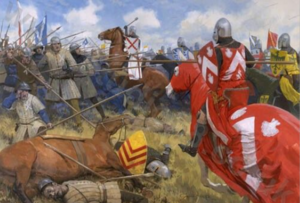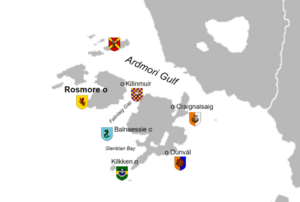Medieval Ardmore

Medieval Ardmore is the history of the Kingdom of Ardmore during the medieval period, which extended in the islands from the 9th century to the early 17th century. Predating this period Ardmore was in the classical and tribal period. During this time, Ardmore was heavily influenced by Levantine and Occidental influences, and these influenced the multitude of different duchies and counties on the islands, which had gradually evolved from the tribal and clan system that had been in place or centuries before hand. Arts, poetry, and music all developed independelty but with some influences from larger medieval states such as the Holy Levantine Empire, where instruments and artisans travelled to Ardmore as its ports were considered friendly to foreign merchants and trade as they expanded in the Sea of Canete.
The Early period of Ardmore's medieval history consisted of a significant amount of infighting and a power struggle amongst dominant clans on the island as a feudal system emerged. Fighting lasted for decades, with the Kingdom of Ardmore beginning to take shape as duchies began to expand and intermarry, with wars becoming less frequent by the late 1100s. These duchies would eventually sit for the Council of Moear, where they anointed the Duke of Rosmore as the King of Ardmore. This period saw the consolidation of the remaining Ardmori duchies in the Duke's War, a series of conflicts that lasted 80-100 years (historical sources vary). After the consolidation of the Kingdom of Ardmore, the Rosmore Dynasty then conducted a campaign to conquer the Wissel Islands, a small series of islands to the Northeast of Ardmore Proper. By the end of 1600, Ardmore had emerged as a strong economic power owing to its flourishing ports and strong guilds, as well as the lack of open civil conflict in the last two centuries of the Kingdom's medieval history.
Early Medieval Period (800-1200)
The early period of Ardmori medieval history is defined by the expansion of the existing clan system to a feudal hierarchy and the infighting between different duchies and counties within the islands. While there was generally less conflict in Ardmore than on the continent of Levantia proper, the island's small population and largely agrarian economy was impacted heavily as different factions destroyed or razed much of the island's fragile farmland and fishing docks, which would eventually lead to an economic collapse in the late 1100s.
Age of Raiders

The Age of Raiders was a period of Ardmori history wherein the warring clans of the Ardmori Isles began to structure their houses and dynasties, as well as construct the first castles and longships. While traders and merchants from Levantia had long visited the islands due to their proximity to Calinthia and Urcea, Ardmore was largely seen as a backwater area with no significant economic value and was not strategic enough to merit conquest. Ironically, these two factors would be the largest contribution to Ardmore's continued independence until the Ardmori Civil War. Ardmore's clans were loosely organized around extended families and functioned as cooperative organizations, having a common set of shared values of honour and a strict code of discipline for social hierarchy. This over time progressed into formalized structures where a feudal structure emerged, much akin to those already existing in the Holy Levantine Empire.
To amass wealth and capture livestock, both of which were difficult to obtain on the islands due to their rocky and non-arable nature, the Houses of Ardmore would conduct land raids against Urcea and Calinthia. The former however had a significant military presence and was drastically less likely to be raided as the nobility and warriors of the Ardmori Isles saw it as a dangerous adventure from which they were unlikely to return. One of Ardmore's first great heroes, Pádraig MacDowell, a low noble of House Kilkken, was killed and his half dozen ships razed on the Urcean coast in 877, which was considered to be one of the last raids against the Urcean coastline. Raids in Calinthia were usually undertaken by six to ten longships, each carrying approximately forty warriors. The raids usually avoided larger urban centres and fortifications, instead focusing on small religious places of worship and villages, where the raiders could successfully pillage and return to their ships unchallenged. The practice of mainland raiding gradually disappeared by the late 900s, as infighting amongst Ardmori houses had required warriors to defend their homes on the Isles.
multiple clans begin to consolidate gains
largest army ~5,000 raids into Calinthia
limited raids into urcea
cross island raiding
North Island War
Duchy of Rosmore v. County of Kilinmuir + County of Wissel support County of K
933-981
First use of siege equipment
2 major battles, Duchy of Rosmore victorious, borders of north island established and ducal limits set (County of K doesn't swear fealty though, remains independent)
Failed Conquest
Duchy of Dunval fails to conquer Kilkken in the South Island War (944-962)
Large war pits Dunval + Craignaisaig against Kilkken and Balnaessie
Major sea battle in the Bay
1 siege of Kilkken fails when Bal breaks it
White peace
Ducal Power Struggles
1061-1149
Kilinmuir swears fealty to Rosmore (marriage alliance brings them into the fold) Dunval amalgamates Craig and Bal
War is Rosmore (+) versus Dunval
Kilkken joins late on Rosmore side (historical bias against Dunval)
Rosmore wins
Cultural Impacts
Economic Collapse
Caused by wars crippling the economy and farming
Late Medieval Period (1200-1600)
Royal Consolidation
Council of Moear to decide who is in charge to prevent economic collapse again
Duke's War - civil war where there is a fight to not submit to the King of Ardmore as assigned (Dunval and Killken + Wisssel against Rosmore)
1277-1365
Wide ranging civil war
siege of craig
sacking of bal
2 battles won by Ros, they submit the dukes
Establishment of the Kingdom of Ardmore
Duchy of Rosmore becomes seat of power
Consolidation complete
Wissel Isles Conquest
Siege of Something
Early Colonial Efforts
Religion in Medieval Ardmore
Culture
Major Figures
Houses of Ardmore

Duchy of Rosmore
Duchy of Kilikken
Duchy of Dunval
County of Kilinmuir
County of Balnaessie
Lord Mayorship of Craigaisnaig
County of Wissel
Significant Events
Note for Admins: Urc I'm aware that this is probably a little fucked up I'll read all the Levantine Medieval history later I am just trying to brain dump some thoughts first then I'll work it into the existing framework.